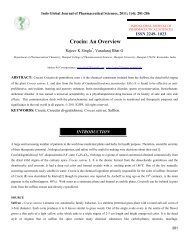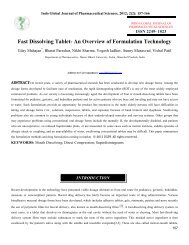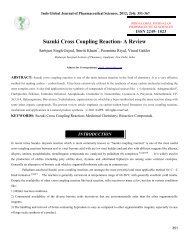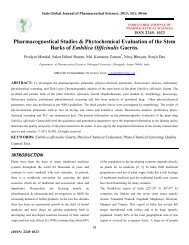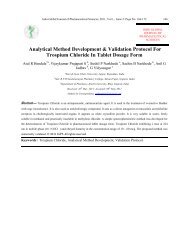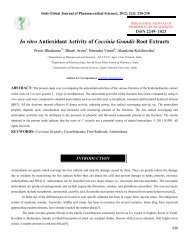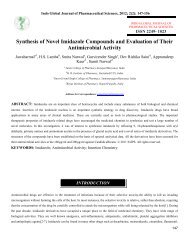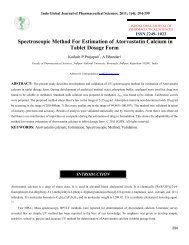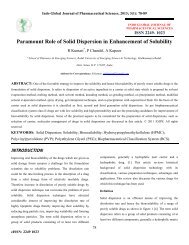Swelling System: A Novel Approach Towards Gastroretentive Drug ...
Swelling System: A Novel Approach Towards Gastroretentive Drug ...
Swelling System: A Novel Approach Towards Gastroretentive Drug ...
- No tags were found...
Create successful ePaper yourself
Turn your PDF publications into a flip-book with our unique Google optimized e-Paper software.
Indo-Global Journal of Pharmaceutical Sciences, 2011, Vol 1., Issue 3: Page No. 234-242The current controlled release technology has made it possible to release drugs at a constant release rate for longer periods of timeranging from days to years. However, this benefit has not satisfied a variety of important drugs that1. Are locally active in the stomach2. Gets absorbed from the stomach or in the upper small intestine3. Are unstable in the intestinal or colonic environment4. Exhibit low solubility’s at high pH values. 4These limits promoted the development of gastroretentive drug delivery systems (GRDDSs). <strong>Gastroretentive</strong> dosage forms are drugdelivery systems which remain in the stomach for an extended period of time and allow both spatial and time control of drugliberation. Basically gastroretentive systems swells following ingestion and is retained in the stomach for a number of hours, while itcontinuously releases the incorporated drug at a controlled rate to preferred absorption sites in the upper intestinal tract. 5Gastrointestinal retention depends on many factors such as density of the dosage form, size of the dosage form, fasting or fedcondition, nature of the meal taken, sleep, posture, etc. It also depends strongly on a complicated and unpredictable gastric emptyingwith migrating myoelectric complex motility of the stomach. 6The gastric emptying occurs in both the cases in fasting as well as in fed states. Nevertheless the pattern of motility differsmarkedly in two states. In case of fasted state an interdigestive series of electrical events occurs in cyclic manner both throughstomach and small intestine every 2-3 hours. This electrical activity is termed as interdigestive myoelectric cycle or migratingmyoelectric complex (MMC) which is further divided into four phases;Phase I (Basic Phase):-It is a quiescent period with rare contractions lasting from 40-60 minutes.Phase II (Preburst Phase):-It lasts for 20-40 minutes and consists of intermittent action potentials and contractions thatgradually increase in intensity and frequency as the phase progresses.Phase III (Burst Phase):- This phase is relatively short and represents intense, large regular contractions of 4-6 minutes induration. It is phase III which earns the cycle the term “housekeeper” waves, as it enables to sweep away all undigestedmaterials out of stomach and down to the small intestine. It has been observed that as phase III of one cycle reaches the endof small intestine, phase III of the next cycle begins in duodenum.Phase IV:-It lasts for 0-5 min. It takes place between phase III and phase I of two consecutive cycles.7, 8.Studies revealed that in the fed state, the gastric emptying rate slowed since the onset of MMC is delayed.Requirements for gastric retention. 9One of the key issues is that the dosage form must be able to withstand the forces caused by peristaltic waves in the stomach and theconstant contractions and grinding and churning mechanisms. To function as a gastric retention device, it must resist premature gastricemptying. Furthermore, once its purpose has been served, the device should be removed from the stomach with ease.235





